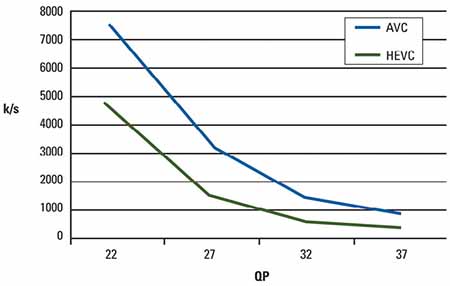HEVC and the Future of 4K Distribution

Elemental Technologies tested its HEVC technology on a Red camera during a soccer match between
the Portland (Ore.) Timbers and the Seattle Sounders.
NEW YORK—With ultra-high definition TV rolling out this year, viewers will see a sharper picture with better color depth, but delivering 4K to the viewer will require deploying the HEVC compression standard.
HEVC, short for “High Efficiency Video Coding,” was developed jointly by the ISO/ IEC Moving Picture Experts Group and ITU-T Video Coding Experts Group as a successor to H.264/MPEG-4 AVC. In optimum scenarios this compression technology can double the data compression ratio compared to H.264, or at the same time provide substantially improved video quality at the same bit rate. It is also a somewhat future-proof technology in that HEVC can support 8K UHD and resolutions up to 8,192 x 4,320.
COMPRESSION SQUARED
The newest version of HEVC was published earlier this year and includes range extensions that support enhanced video formats, scalable coding extensions and multiview extensions. HEVC can thus push more video into the traditional pipe, but according to Avni Rambhia, principal analyst for digital media at media research firm Frost & Sullivan, this also means “there are more calculations so it works a lot harder, but you get better compression.”
The technology is able to accomplish this by compressing segments of the image instead of an entire image.
“Every frame of video is broken into squares,” Rambhia said. “This is also accomplished because each frame of video is not that different from the one before or after, so this is what is known as predictive scaling and it is far more sophisticated than H.264.”
Instead of encoding each and every pixel from every single frame, HEVC instead encodes an initial frame and then essentially re-encodes what changes. This is a major step from the previous generation of encoding technologies.
The professional video industry's #1 source for news, trends and product and tech information. Sign up below.
“It hasn’t been quite 10 years between introductions, but just as H.264 was a generational leap forward and reduced what MPEG-2 could do, we’re now making the jump to HEVC,” said John Pallett, director of product marketing for Telestream, a Nevada City, Calif.-based developer of video processing and distribution technology. “More importantly this technology has matured much faster than H.264. The promise can actually be realized today but the settop infrastructure is still the holdup. The encoding technology is there, but the infrastructure is still being realized.”
TESTS LOOK GOOD
That isn’t to say that companies haven’t been feverishly testing HEVC to deliver 4K in all its glory.

Pat Waddell
Elemental Technologies has been doing a number of trials for the past year or so according to Keith Wymbs, chief marketing officer for the Portland, Ore.-based developer of multiscreen software. “We demonstrated what HEVC could do at the Sochi Games earlier this year, and that was an end-to-end demonstration to a set top box,” he said. “In April we did a similar type of thing over the Internet utilizing Akamai’s delivery stream. That was even more challenging due to the fact that it was over an unmanaged system.”
The content that has been used to test HEVC as a compression technology has mostly been pre-encoded, and it will likely be this sort of content that is first rolled out to satcaster subscribers, as well as from over-the-top entrants to the market such as Amazon, Google and Netflix. The reason for this is that even with its ability to double the data compression rates HEVC requires a lot of bandwidth as well as encoding and decoding time.
BIG DATA
As noted, there are more calculations involved, and as a result 4K could be video content providers’ own version of “big data.” The question is whether today’s processing technology is up to the task required—and at present it probably isn’t, at least not for live content.
“Higher frame rates and higher resolution are an issue because it can’t be encoded and decoded fast enough,” said Pat Waddell, manager of standards and regulatory at Harmonic, a San Jose, Calif.-based provider of digital video infrastructure technology. “What folks are not doing right now in these tests are in real time, at least not the high value content.
“DirecTV is doing non-real-time encoding and non-real time decoding,” Waddell continued. “You are essentially streaming the files to the DVR in the background and then announcing to the viewer that a new program is available. This solves some of the bandwidth issues, so in this way [it] is a VOD application.”
For this to be resolved Waddell added that “Moore’s Law” is going to have to come to the rescue. “But one wonders if Moore’s Law will hit a brick wall at some point to make this impossible,” he said.
HEVC AND THE EARLY ADOPTERS
One other issue that is still being resolved is how HEVC may affect the early adopter, especially in regards to 4K.

Bit-rate reduction curve shows bit-rate savings between H.264 and HEVC.
“One question mark we noted is whether we have a fully specified 4K,” Wymbs said. “Will we come from 8 bit color to 10 bit? There are other enhancements that are unresolved and there are those that haven’t fully been worked out yet.”
However, some customers are moving forward very quickly and the general consensus is that it won’t take a full decade for HEVC to be adopted, or even be replaced. “The good news here is that new solutions could be provided in software updates,” noted Wymbs said.
HEVC will also provide a benefit beyond what it can do for HD as well as 4K.
“If you use HEVC, you can task twice as many channels,” Rambhia said. “This makes economic sense, and if you don’t add new channels, your existing ones can be much better in quality.”
For the satellite providers, including DirecTV, HEVC also can reduce the costs by reducing the bandwidth required to transmit the data. While the set-top box infrastructure may remain an issue, DirecTV has been one operator to find a workaround.
Wymbs said, “DirecTV will get around this issue by utilizing new Samsung TVs that come out next year and these sets will work as the decoder. Google, Amazon and Netflix aren’t waiting, so DirecTV is moving forward.”
The rest of the industry could be facing the proverbial chicken-and-egg scenario—getting the set-top boxes that support HEVC while at the same time providing content to take advantage of it, Pallett said.
“There is more of a push than we saw with HD and it is clear that the early adopters will want UHD/4K,” he said. “The studios are seeing it as a better way to deliver the films and the providers are seeing it as a differentiator, but the egg is still the infrastructure and it will take a while to get there.”
Rambhia said one solution could be pay-per-view.
“HEVC is very good with VOD, and if you exclude the cost on the client side you only need 17,000 to 20,000 4K payper- view customers to make your money back to support a rollout of 4K-capable boxes that utilize HEVC,” he said. “Charging $25 to $40 for special events in 4K would not be unheard of, so DirecTV and other providers could bite the bullet and ship these things out and let pay-per-view pick up the tab.”
Regardless of how it gets there Pallet said he believes HEVC is going to be the future for compression.
“It is real and you’d be hard pressed to find another compression technology that has this momentum behind it,” he said.
